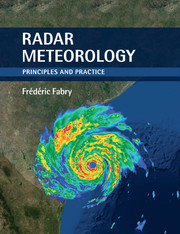Book contents
- Frontmatter
- Dedication
- Contents
- Preface
- Notation
- 1 Meteorology and radar
- 2 Fundamentals of weather radar measurements
- 3 Radar reflectivity and products
- 4 Reflectivity patterns
- 5 Doppler velocity information
- 6 The added value of dual polarization
- 7 Convective storm surveillance
- 8 Monitoring widespread systems
- 9 Radar estimation of precipitation
- 10 Nowcasting
- 11 Additional radar measurements and retrievals
- 12 Cloud and spaceborne radars
- 13 What does radar really measure?
- Appendix A Mathematics and statistics of radar meteorology
- References
- Index
4 - Reflectivity patterns
Published online by Cambridge University Press: 05 June 2015
- Frontmatter
- Dedication
- Contents
- Preface
- Notation
- 1 Meteorology and radar
- 2 Fundamentals of weather radar measurements
- 3 Radar reflectivity and products
- 4 Reflectivity patterns
- 5 Doppler velocity information
- 6 The added value of dual polarization
- 7 Convective storm surveillance
- 8 Monitoring widespread systems
- 9 Radar estimation of precipitation
- 10 Nowcasting
- 11 Additional radar measurements and retrievals
- 12 Cloud and spaceborne radars
- 13 What does radar really measure?
- Appendix A Mathematics and statistics of radar meteorology
- References
- Index
Summary
The basic physics and measurement strategy of weather radar having been established, it is time to turn our attention on the radar observations themselves, as their interpretation forms the core of radar meteorology. Radar echoes have a variety of origins and shapes, each associated with, as well as caused by, the processes that generate the targets being observed. Understanding and differentiating echo patterns must hence come with an understanding of the phenomena that give rise to them.
Types of targets
Targets observed by radar can be separated into three broad categories:
Precipitating weather targets: These are what naturally come to mind when one thinks of weather radar observations: rain, drizzle, snow, hail, etc.
Nonprecipitating weather targets: These include ice clouds, water clouds, and refractive index gradients causing clear-air echoes. The ability to detect each of these will depend on radar sensitivity and wavelength.
Nonmeteorological targets: These include a large variety of targets. Some of these are important to detect such as ash; some others such as insects end up providing information that will prove to be useful for meteorological purposes. Unwanted targets for most meteorological purposes include birds, airplanes, and the ground and sea surfaces. Echoes from unwanted targets are referred to as clutter. Note that someone's clutter may be someone else's signal: aviation radar users refer to weather echoes as clutter!
Despite the large variety of targets, most of them can be recognized by carefully examining the horizontal and vertical structure of their echo. To achieve this, the processes governing their formation and evolution must be well understood. We must therefore explore in some detail the microphysics and dynamics of precipitation formation.
Precipitation processes: a quick overview
In a nutshell, dynamical processes determine the structure and spatial extent of the areas of vertical motion required to generate clouds and precipitation, while microphysical processes control the way water vapor supersaturation, resulting from upward motion, is ultimately transferred into precipitation.
There are several instabilities and processes in the atmosphere that may cause enough vertical motion to generate precipitation. The two most important are the baroclinic instability and the convective instability.
- Type
- Chapter
- Information
- Radar MeteorologyPrinciples and Practice, pp. 43 - 64Publisher: Cambridge University PressPrint publication year: 2015



